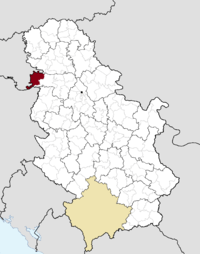Šid
| Šid Шид | ||
|---|---|---|
| Municipality and Town | ||
| ||
 Location of the municipality of Šid within Serbia | ||
| Coordinates: 45°07′N 19°14′E / 45.117°N 19.233°ECoordinates: 45°07′N 19°14′E / 45.117°N 19.233°E | ||
| Country | Serbia | |
| Province | Vojvodina | |
| District | Syrmia | |
| Settlements | 19 | |
| Government | ||
| • Mayor | Nikola Vasić (SNS) | |
| Area[1] | ||
| • Municipality | 687 km2 (265 sq mi) | |
| Population (2011 census)[2] | ||
| • Town | 14,893 | |
| • Municipality | 34,188 | |
| Time zone | CET (UTC+1) | |
| • Summer (DST) | CEST (UTC+2) | |
| Postal code | 22240 | |
| Area code | +381 22 | |
| Car plates | ŠI | |
| Website |
www | |
Šid (Serbian Cyrillic: Шид, pronounced [ʃîːd]) is a town and municipality in the Syrmia District of Vojvodina, Serbia. Šid town has a population of 14,893, and Šid municipality 34,188.
Name
In Serbian, the town is known as Šid (Шид), in Croatian as Šid, in Hungarian as Sid, in German as Schid, in Slovak as Šíd, and in Rusyn as Шид.
History
Šid was firstly mentioned in 1702. At first, settlement was part of Danubian Military Frontier, but since the middle of the 18th century, it was part of the Syrmia County of the Habsburg Kingdom of Slavonia. In 1848-1849, Šid was part of Serbian Vojvodina, and in 1849-1860 part of Voivodeship of Serbia and Banat of Temeschwar. After the abolishment of the voivodeship in 1860, Šid was again incorporated into Syrmia County of the Kingdom of Slavonia. In 1868, Kingdom of Slavonia was joined with the Kingdom of Croatia into the Kingdom of Croatia-Slavonia, which was part of the Kingdom of Hungary and Austria-Hungary. Šid was a district center within Syrmia County. In 1910, ethnic Serbs were in absolute majority in the town,[3][4] while other sizable ethnic groups included Rusyns, Slovaks and Croats.
In 1918, the town first became part of the State of Slovenes, Croats and Serbs, then part of the Kingdom of Serbia and finally part of the Kingdom of Serbs, Croats and Slovenes. From 1918 to 1922, Šid was part of the Syrmia county, from 1922 to 1929 part of the Syrmia oblast, from 1929 to 1931 part of the Drina Banovina, from 1931 to 1939 part of the Danube Banovina, and from 1939 to 1941 part of the Banovina of Croatia. During World War II, from 1941 to 1944, the town was occupied by Axis troops and was included into the Pavelić's Independent State of Croatia. In 1944, Šid was liberated by Yugoslav partisans and until April 1945, a number of battles of the Syrmian Front campaign were fought near the town. The Yugoslav Partisans mined the local Catholic church during the offensive in late 1944.[5] Since 1944, the town is part of Vojvodina, which (from 1945) was an autonomous province of Serbia and Yugoslavia.
On 5 November 1991, the Serbian government accused Croatian forces of firing 15 artillery rockets into the city, killing four people and wounding 12 in what became the first attack on Serbian soil during the Yugoslav Wars.[6][7] In 2009, Šid was declared mine-free after demining actions to remove explosives dating from the conflict.[8]
Inhabited places

Šid municipality encompasses of town of Šid, and following villages:
- Adaševci
- Batrovci
- Bačinci
- Berkasovo
- Bikić Do
- Bingula
- Vašica
- Višnjićevo
- Gibarac
- Erdevik
- Ilinci
- Jamena
- Kukujevci
- Ljuba
- Molovin
- Morović
- Privina Glava
- Sot
Ethnic groups (2002 census)
The population of the Šid municipality:
Most of the settlements in the municipality have an ethnic Serb majority. The settlement with Slovak ethnic majority is Ljuba. Ethnically mixed settlements are Bikić Do (with relative Rusyn majority) and Sot (with relative Serb majority).
Culture
Near the Privina Glava village is Privina Glava Monastery. According to the legend, the monastery was founded by the squire Priva in the 12th century.
In Šid, there is a museum dedicated to an important Serbian artist Sava Šumanović, and a museum of naïve art "Ilijanum" consisting of more than 300 works of fine art, mainly paintings.
Twin towns – Sister cities
There are three official sister cities of Šid:
People
- Milenko Atanacković
- Mira Banjac
- Ilija Bašičević Bosilj
- Dejan Bulatović
- Željko Fajfrić (b. 1957), Serbian academic, lawyer and historian
- Blagoje Jastrebić
- Vitomir Korać
- Herbert Kraus (1910-1970), Yugoslav partisan
- Georgije Magarašević
- Žarko Miladinović
- Bojan Milanović
- Grozdana Olujić
- Boško Simonović
- Sava Šumanović
See also
External links
- Official Site of Šid (Serbian)
- Russian Castle (Serbian)
- Šidski portal (Serbian)
References
- ↑ "Municipalities of Serbia, 2006". Statistical Office of Serbia. Retrieved 2010-11-28.
- ↑ "2011 Census of Population, Households and Dwellings in the Republic of Serbia: Comparative Overview of the Number of Population in 1948, 1953, 1961, 1971, 1981, 1991, 2002 and 2011, Data by settlements" (PDF). Statistical Office of Republic Of Serbia, Belgrade. 2014. ISBN 978-86-6161-109-4. Retrieved 2014-06-27.
- ↑ http://img190.imageshack.us/img190/3899/vojvodina1910.png
- ↑ http://www.americanhungarianfederation.org/images/vojvodina_ethnic_map1910.gif
- ↑ Obnova crkve Presvetog Srca Isusova u Šidu, Slobodna Dalmacija
- ↑ Serbs accused Croatia of second attack Reuters, 5 November 1991
- ↑ Mojsilovich, Julijana (5 November 1991). "Serbians claim fighting spills into Serbia for first time". Associated Press.
- ↑ Svečano obiljžen kraj razminiranja u Šidu, Republika Srbija
| Wikimedia Commons has media related to Šid. |



